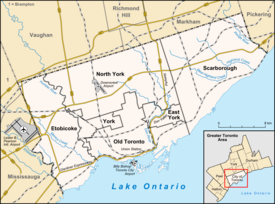Upper Beaches
| Upper Beaches | |
|---|---|
| Neighbourhood | |

Typical houses in the Upper Beaches
|
|
 Map of Upper Beaches |
|
| Location within Toronto | |
| Coordinates: 43°40′56″N 79°18′12″W / 43.682088°N 79.303272°WCoordinates: 43°40′56″N 79°18′12″W / 43.682088°N 79.303272°W | |
| Country |
|
| Province |
|
| City |
|
| Community | Toronto & East York |
| Established | 'Norway' |
| Changed Municipality | 1888 East Toronto from York 1908 Toronto (former) from East Toronto 1998 Toronto from Toronto (former) |
| Government | |
| • MP | Nathaniel Erskine-Smith (Beaches-East York) |
| • MPP | Arthur Potts (politician) (Beaches-East York) |
| • Councillor | Mary-Margaret McMahon (Ward 32 Beaches-East York) |
The Upper Beaches is a rather recently coined name for the neighbourhood directly north of the Beaches area in Toronto, Ontario, Canada. It stretches from Coxwell Avenue in the west to Victoria Park in the east. The southern border is Kingston Road, while the northern boundary is generally considered to be the Canadian National Railway tracks between Gerrard Street and Danforth Avenue. The western part of the area was originally called Norway, and the larger area was once part of the Town of East Toronto. The name "Upper Beaches" was first used by developers and real estate agents around the period of 2001 to 2003 for the selling of houses on redeveloped land in the area, and was used as a marketing tag to attract buyers. The area was never considered part of the Beaches neighborhood, but was close to it. The city's current name for this area is East End Danforth, though that is rarely used. The city also includes the buildings along and just north of Danforth Avenue in the neighbourhood. The western portion between Woodbine Avenue and Coxwell is referred to by the city as Woodbine Corridor.
Predating development along Toronto's Beaches, Norway was a postal village in what is today the eastern part of Toronto. There is no evidence of Norwegian settlement in the area. Rather, the name likely comes from the Norway Pines that dominated the region, and whose harvesting was one of the main industries for the community. The most prominent landowner in the area was Charles Coxwell Small, who tried strenuously to have the town renamed to Berkeley, after his hometown in Britain. The name Norway stuck.
The village’s post office was originally a wooden structure built in 1825, today the site of 320 Kingston Road. The Norway Steam Mills, a steam powered saw mill began operations in 1835 near Woodbine and Kingston Road, established by the iron mongers Wragg & Co., who advertised Norway pine as a specialty.
...
Wikipedia

